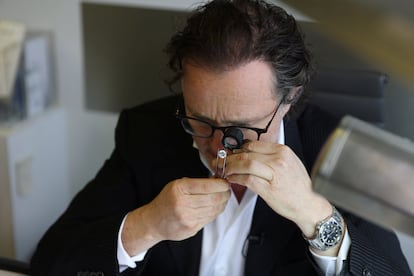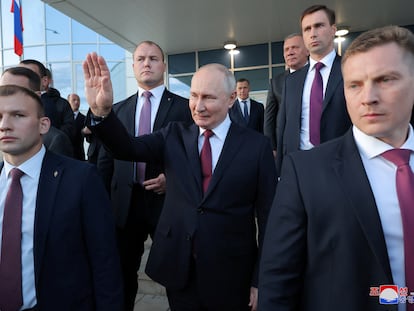EU moves to ban Russian diamonds after months of negotiations
A delegation of G7 experts will meet in Antwerp, the great historical center of the sector, to assess formulas for tracking and tracing Russian gemstones


More than 600 days after Russia began its large-scale invasion to destroy Ukraine’s sovereignty, the West continues to look for ways to strangle its war economy. Now, after months of negotiations, the European Union is moving to ban diamonds from Russia, which supplies a third of global demand. The move is linked to the G7 — the group made up of Germany, Canada, the United States, France, Italy, Japan and the United Kingdom (the EU is an unlisted member) — which is also discussing a ban on Russian diamonds.
Brussels is now finalizing its 12th package of sanctions against Russian entities and individuals, and is working to include Russian diamonds in it — or at least in a later annex — according to several EU sources.
After the G7 meeting in Japan, G7 foreign ministers and Josep Borrell, the high representative of the EU for Foreign Policy, issued a joint statement on the plan. “In order to reduce the revenues that Russia extracts from its exports, we will accelerate our consultation on energy, metals, and all non-industrial diamonds, including those mined, processed or produced in Russia,” the document stated.
However, technical details still need to be ironed out with respect to implementing the ban on Russian diamonds in Western markets, which represent 70% of the global demand for jewelry with these gems. The key is working out how to trace the stones (the measure will primarily focus on rough gems of one carat or more) to their origin. And it’s no simple matter.
A team of G7 experts will visit Belgium this week to analyze traceability proposals, which guarantee and document that gems are not arriving from Russia. The team will meet with representatives of the European Commission and will pass through Antwerp in Belgium, the historic heart of the rough diamond trade, where they will speak with companies in the sector. This visit, which coincides with a meeting of EU foreign ministers, comes after the experts made a similar trip to India, which is where 90% of the world’s rough diamonds are cut and polished.

Russian oil and gas are already under G7 and EU sanctions, but there are exceptions and loopholes that allow the Kremlin to circumvent the ban and reach Western markets. Now, after months of pressure and doubts about how to make the sanctions effective, Brussels is also preparing to focus on diamonds, a market which generates more than €3.7 billion ($3.95 billion) a year in revenue for the Kremlin, particularly thanks to the diamond mining company Alrosa, which is controlled by the Russian government.
The European Commission previously tried to include Alrosa in its list of Russian companies under sanctions in September 2022, as EL PAÍS reported; although on that occasion it was for supporting the Russian Navy by economically sustaining the Alrosa submarine. That proposal did not go ahead, since sanctions require unanimous approval by the 27 EU member states.
Belgium concerned about market
In the EU, Belgium has interests in the diamond trade due to its large port of Antwerp. However, the Belgian government — which initially did not support the proposal — says that it now backs the ban on Russian gemstones, but argues that a tracking system that does not harm the rest of the market is needed. The current system is based on documents that certify the origin of gems, such as the “Kimberley process,” which certifies that gems are not blood diamonds. But these documents can be altered, and Belgium argues that a better system is needed.
Belgian Prime Minister Alexander De Croo said a few days ago that the ban on Russian diamonds is getting “closer.” However, once the sanctions are approved at the European level, they could still take months to come into force. Belgium is considering a deadline of the first quarter of 2024. For the ban to start working, a technological tracking system, which x-rays the stones (raw and of a certain size) so that they can be traced all along the chain, must be implemented first.
The United States — the largest consumer of diamonds for jewelry — has already sanctioned Russian diamonds (rough and those cut and polished in Russia). However, trade in these precious stones has hardly been affected in Russia, which, according to experts and analysts, has managed to evade the U.S. ban and circumvent the sanctions by placing the gems on the market through other countries and claiming other origins.
Some of the world’s leading diamond jewelry sellers claim that they have not been buying Russian gems since the beginning of the full-scale invasion of Ukraine, but loopholes in the documents proving the origin of the diamonds mean they continue to be put on the market, say diplomatic sources familiar with the debate on European sanctions. It is now a matter of ensuring that the European measure does not contain these loopholes.
Sign up for our weekly newsletter to get more English-language news coverage from EL PAÍS USA Edition
Tu suscripción se está usando en otro dispositivo
¿Quieres añadir otro usuario a tu suscripción?
Si continúas leyendo en este dispositivo, no se podrá leer en el otro.
FlechaTu suscripción se está usando en otro dispositivo y solo puedes acceder a EL PAÍS desde un dispositivo a la vez.
Si quieres compartir tu cuenta, cambia tu suscripción a la modalidad Premium, así podrás añadir otro usuario. Cada uno accederá con su propia cuenta de email, lo que os permitirá personalizar vuestra experiencia en EL PAÍS.
¿Tienes una suscripción de empresa? Accede aquí para contratar más cuentas.
En el caso de no saber quién está usando tu cuenta, te recomendamos cambiar tu contraseña aquí.
Si decides continuar compartiendo tu cuenta, este mensaje se mostrará en tu dispositivo y en el de la otra persona que está usando tu cuenta de forma indefinida, afectando a tu experiencia de lectura. Puedes consultar aquí los términos y condiciones de la suscripción digital.
More information
Archived In
Últimas noticias
Most viewed
- Oona Chaplin: ‘I told James Cameron that I was living in a treehouse and starting a permaculture project with a friend’
- Sinaloa Cartel war is taking its toll on Los Chapitos
- Reinhard Genzel, Nobel laureate in physics: ‘One-minute videos will never give you the truth’
- Why the price of coffee has skyrocketed: from Brazilian plantations to specialty coffee houses
- Silver prices are going crazy: This is what’s fueling the rally










































